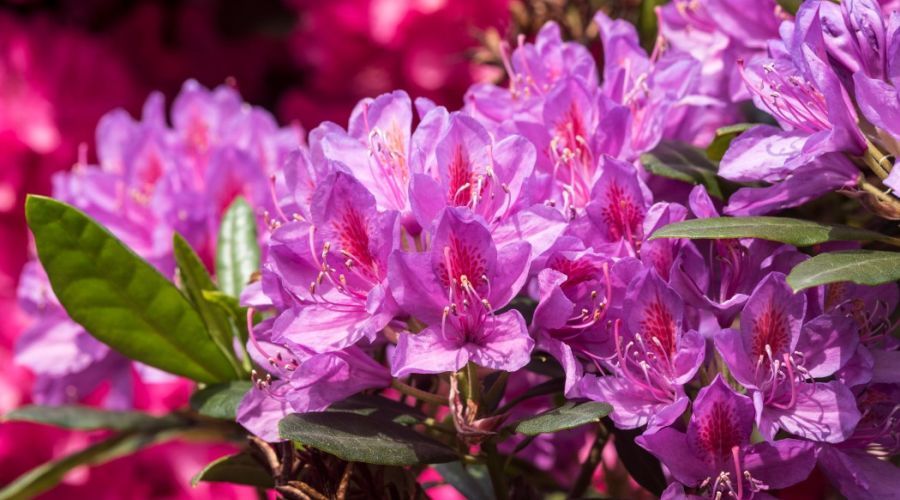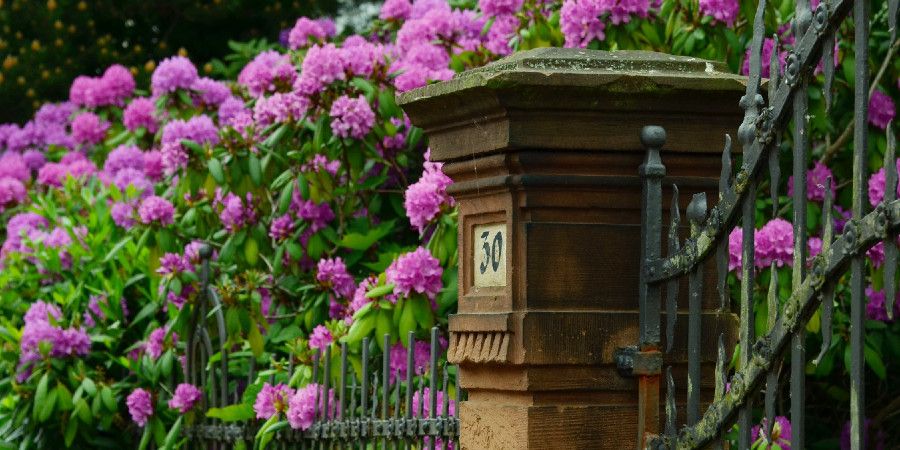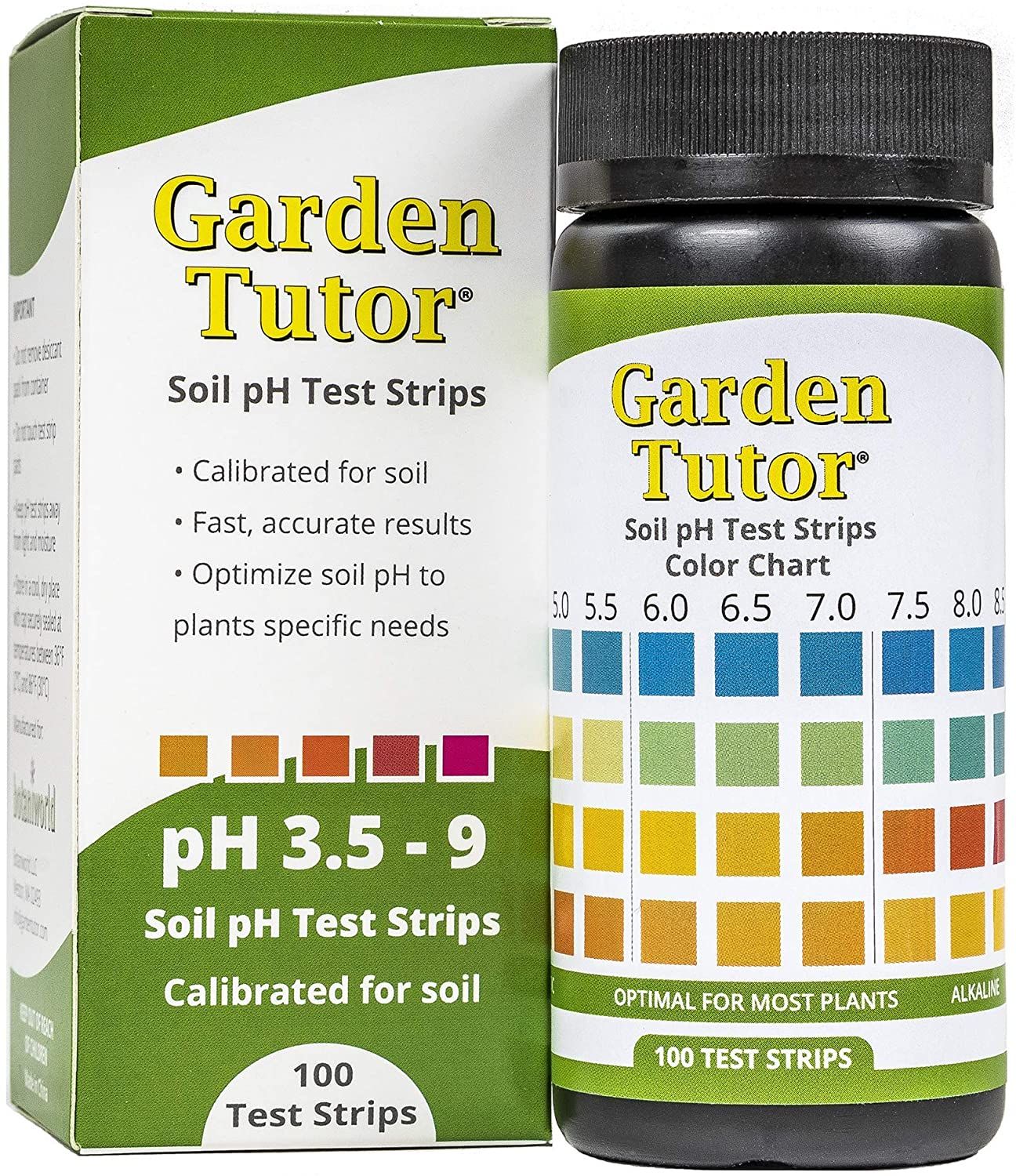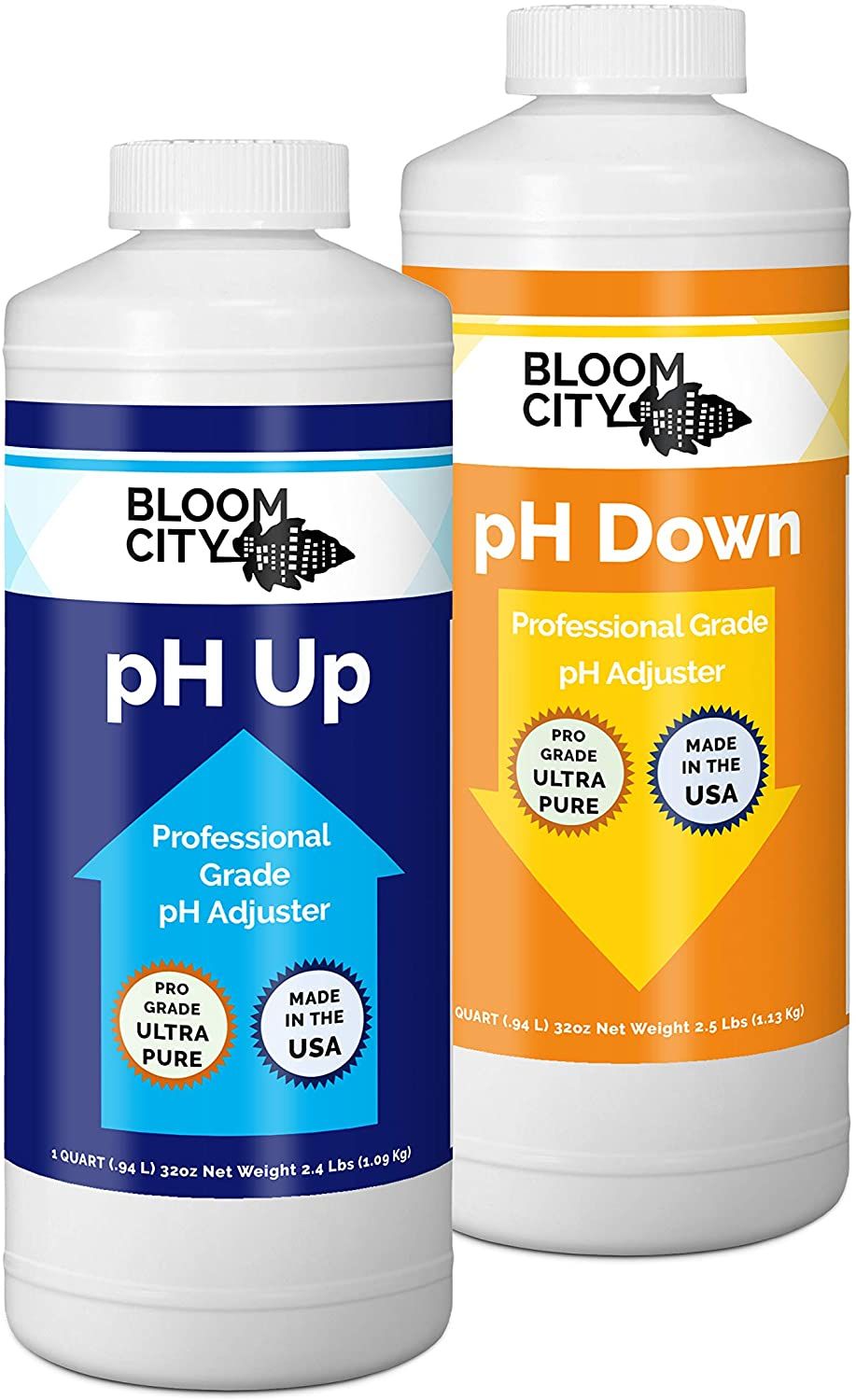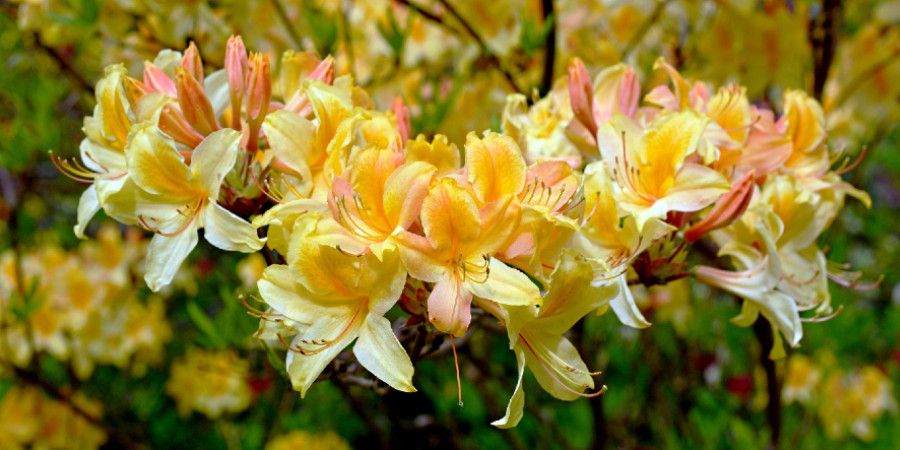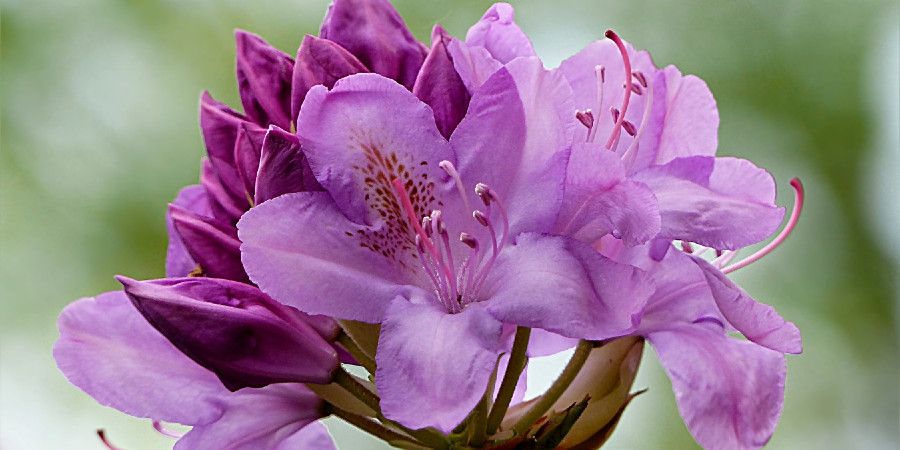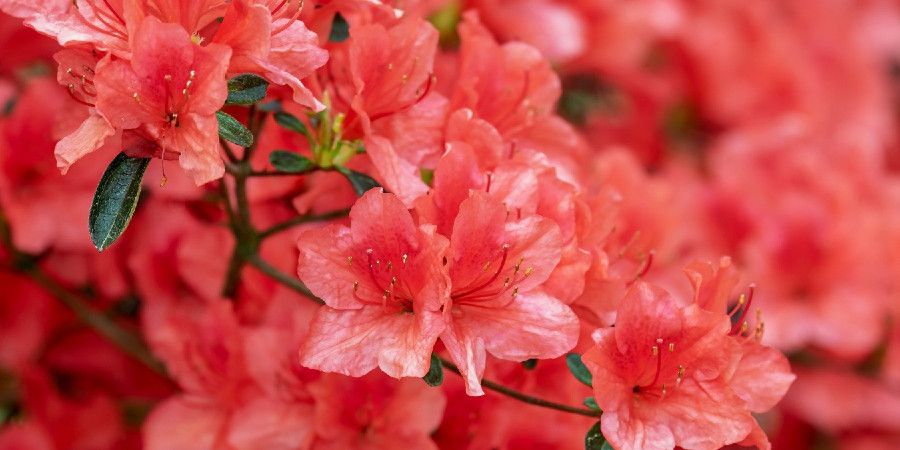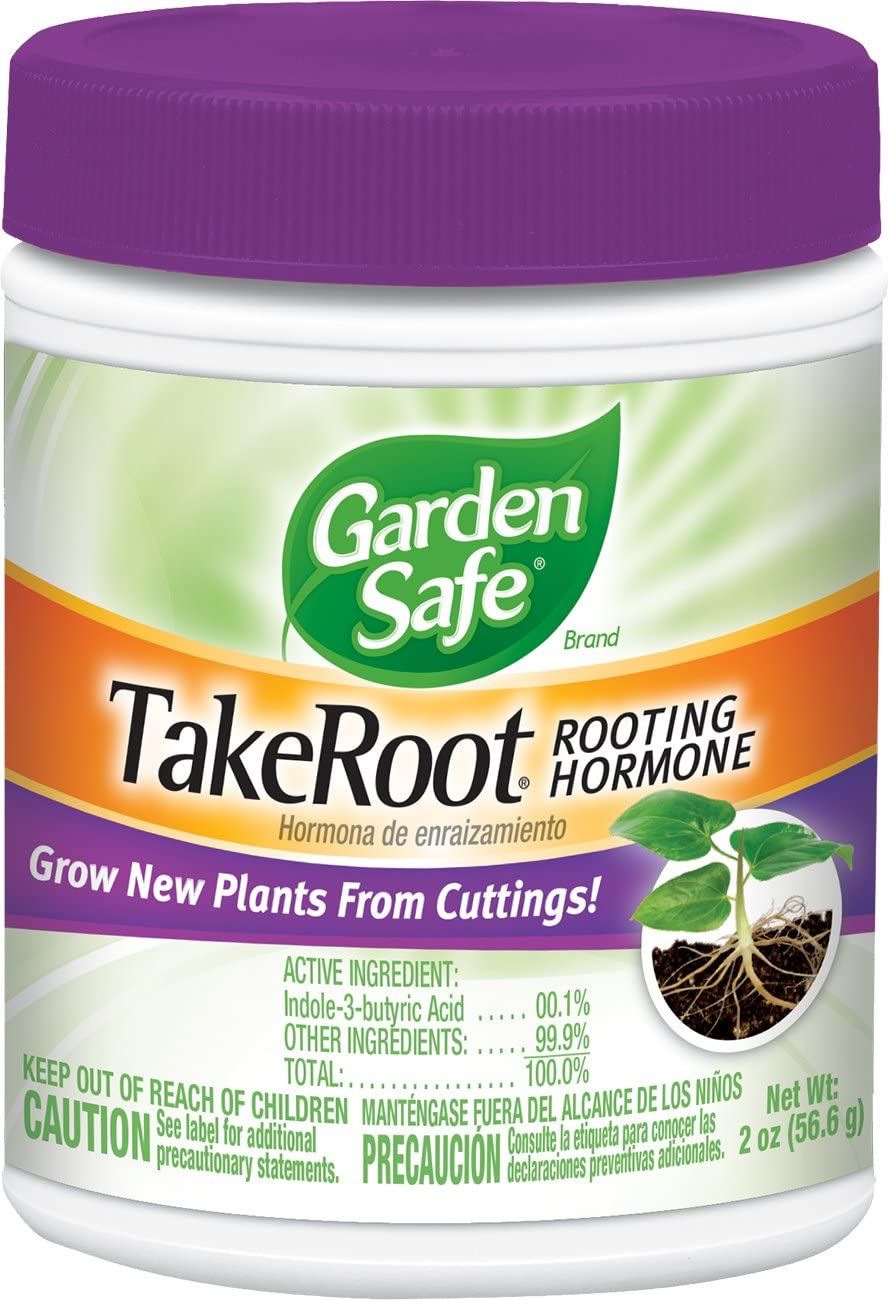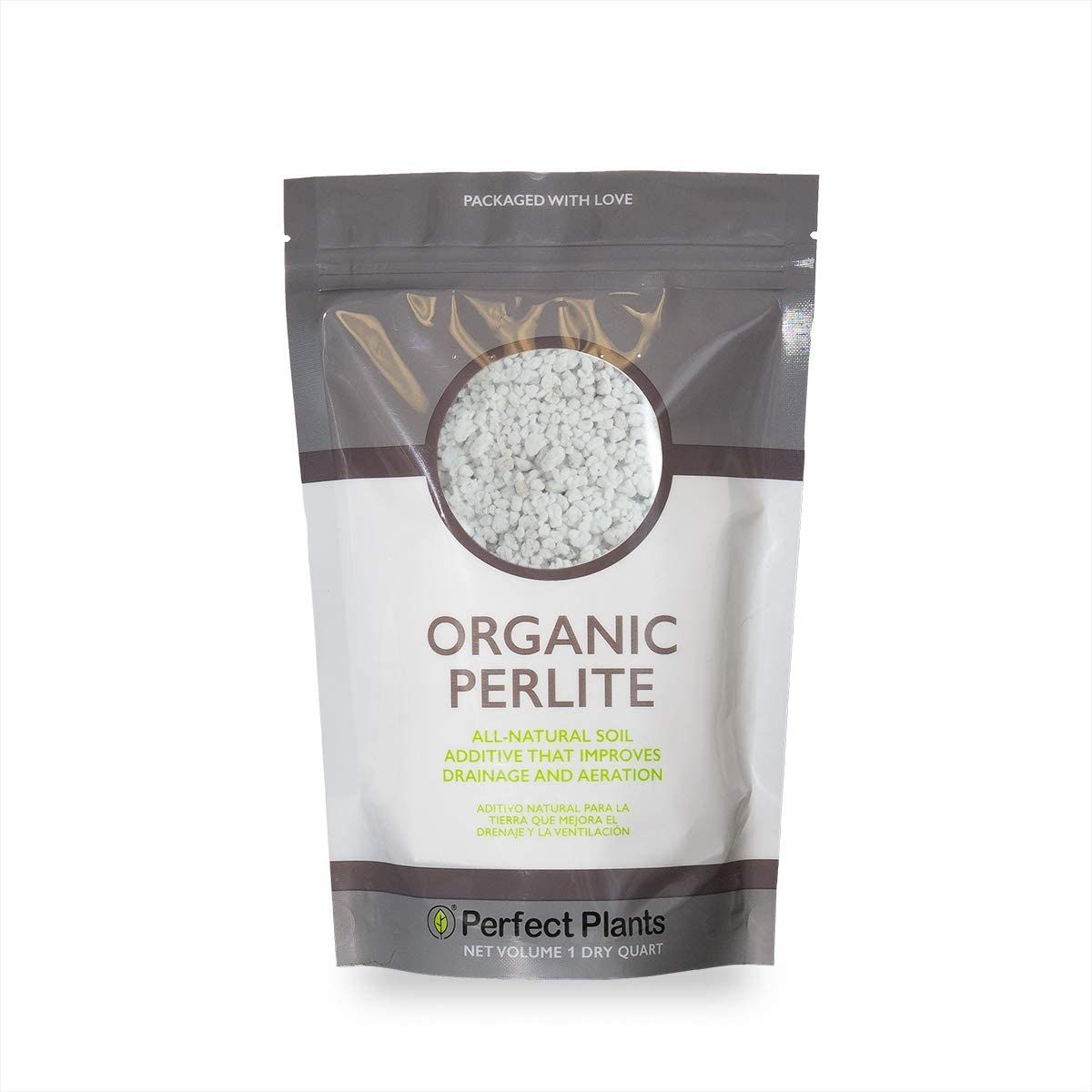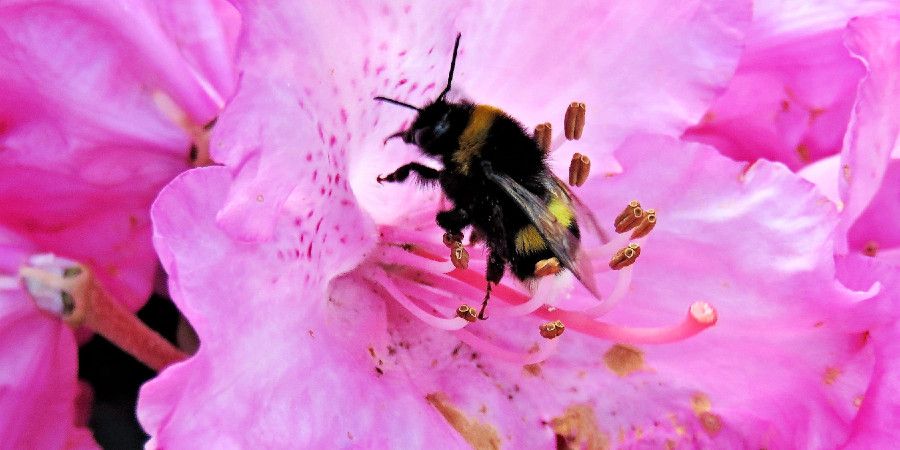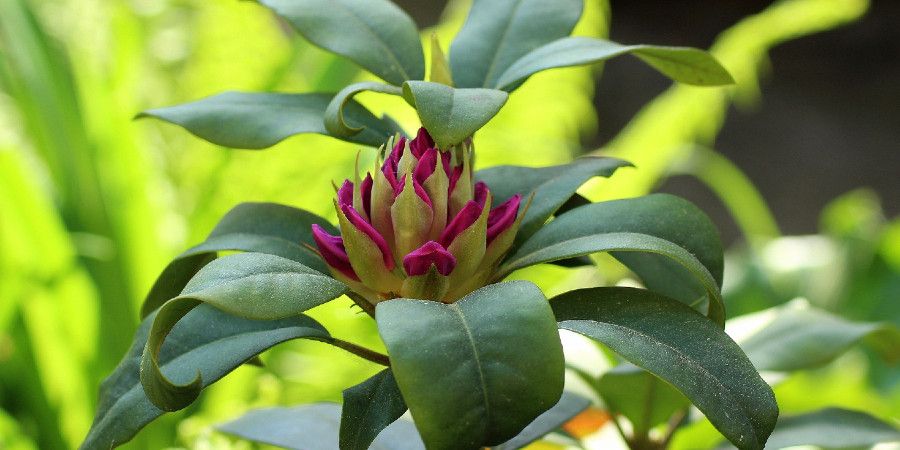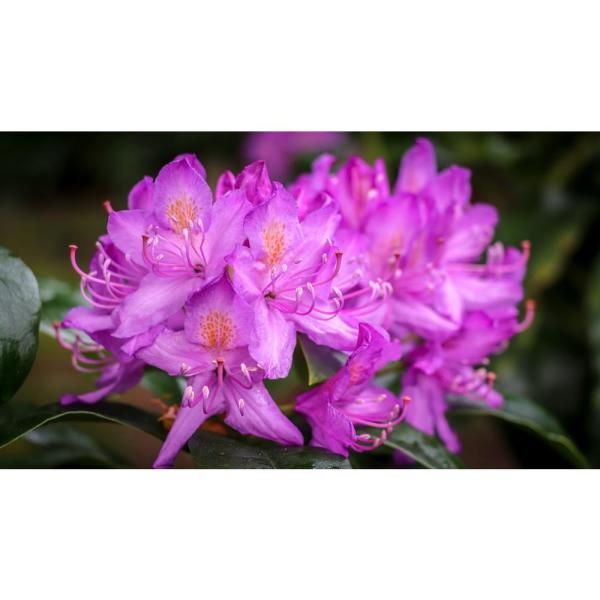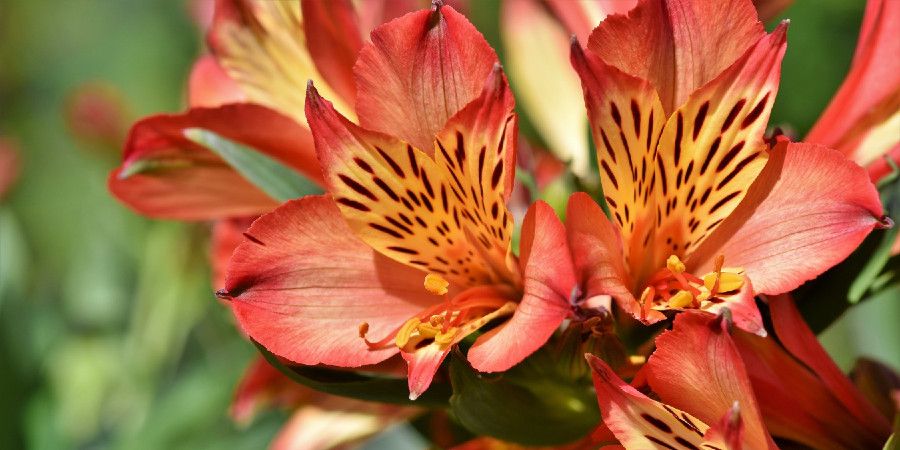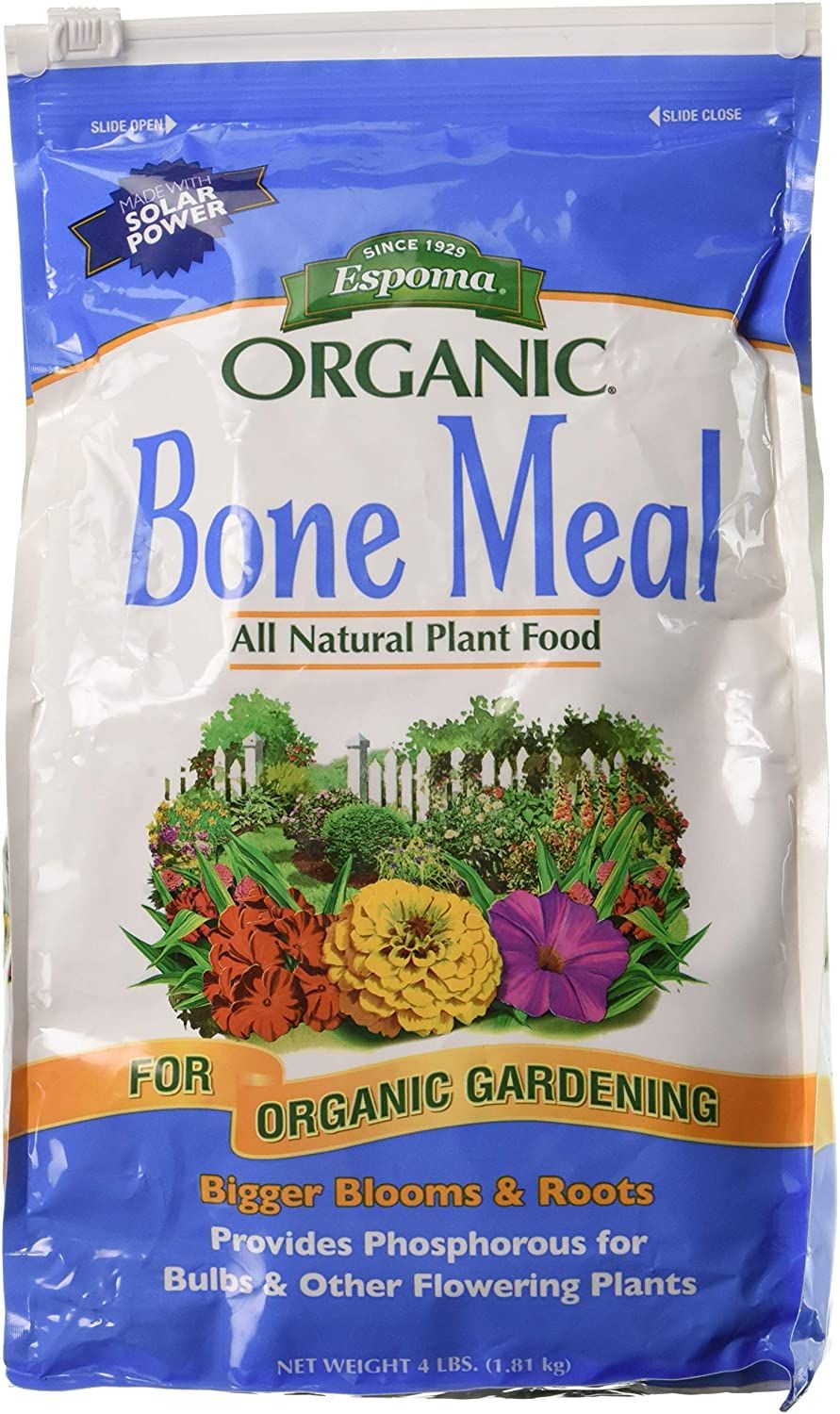Rhododendrons offer blossoms popping out in orange, yellow, deep wine red, vibrant crimson, pale pink, or deep shades of purple and pink. The tubular, funnel, or bell-shaped flowers are only part of the beautiful package in these stunning plants that grow natively around the world. The rich greenery comes in shades from pale green to deep purple greens, as well.
The plants come in varieties that work as small border plants to tall trees and bushy shrubs for natural privacy screens around the home. They tend to be low maintenance and depending on the variety, do very well in almost any climate.
Rhododendron Facts at a Glance
Image credits: congerdesign via Pixabay
- Common Name(s): Alpenrose, snow-rose, or rusty-leaved alpenrose
- Scientific Name: Rhododendron ferrugineum
- Ease of Care: Easy to moderate
- Light: Rhododendrons like light to medium shade. Avoid planting them on the south or southwest side of a building.
- Water: Water immediately after planting. Continue checking root ball and topsoil for dryness. Water whenever the soil begins to dry out. Once established, rhododendrons require an average of 1" of water per week.
- Temperature: Certain species survive in temperatures as low as -35 Fahrenheit. Many do well in much warmer temperatures into tropical climates. Most varieties thrive in hardiness zones 4 to 8.
- Height: Depending on the variety, rhododendrons may grow anywhere from 5 feet tall to 20+ feet.
- Growth Rate: Most varieties grow approximately 3 inches per year until reaching their maximum height in about ten years.
- Pest: Rhododendrons are not typically susceptible to insect pests, but they may occasionally have rhododendron borers, rhododendron lace bugs, or weevils.
- Disease: These ornamental shrubs may develop bud blast, powdery mildew, petal blight, leaf gall, lead spots, or rust.
- Poisonous: Rhododendrons are poisonous to both animals and humans. While serious poisoning is unlikely with small amounts ingested, large amounts of ingestion of any parts of the plant or honey made from the flowers can be life-threatening. If even small amounts are consumed, consult poison control immediately.
Caring for Rhododendrons
There are certain things that rhododendrons are fussy about, but mostly, the plants are pretty easy to care for.
Lighting Needs
Lighting is one of the things rhododendrons are fussy about. They like just the right amount – no more and no less.
To keep them happy and healthy, they should be planted where they will get some direct sunlight in cooler times of the day (to midday) and dappled shade for the afternoon. They should not be planted against south or southwest walls.
Soil Needs
"Rhodies," as gardeners often call the plants, require the right pH levels and proper drainage to thrive. The soil should have a pH between 4.5 and 6 and never hit Alkalinity (7.0+). Use a soil testing kit to verify the numbers and make adjustments as needed with a pH Control Kit.
Garden Tutor Soil pH Test Strips Kit
Using a soil testing kit for pH levels can help sensitive plants stay healthy and strong for decades to come.
Bloom City Professional ph Up Down Kit
Adjusting soil pH can keep your plants healthy and strong.
Be sure to adjust pH slowly to avoid shocking the plants. Lower or raise only by 0.5 at a time until the target is reached.
Image credits: anncapictures via Pixabay
Watering Needs
Rhododendrons need their roots to be perpetually wet, which means they need regular watering. It's important not to overwater, however, as root rot will occur or the plants will "drown." They need about one inch of water per week once they are established.
Mulch and Fertilizer Needs
When you plant the rhododendrons, be sure to add two to five inches of pine needles, pine bark chips, or others around the soil roots to protect them, help with soil drainage, and keep the soil moist as needed. Every spring add another 2two to five inches of the mulch to replenish what was lost the previous year.
Use fertilizer sparingly and only when flower buds swell during the spring or autumn. Too much fertilizer will burn the plants.
Protect the Plants From the Wind
Persistent wind, especially cold wind, may damage the foliage of your rhododendrons. Consider building a windbreaker around the plant for the coldest months if your area tends to be windy.
Avoid Planting Near Sidewalks and Foundations
Rhodies don't do well near concrete and cement. The lime leaches from the material into the soil, raising alkalinity and harming your plants. If you must plant the shrubs near such structures, monitor the soil closely to keep the pH in check.
Planting Shrubs
- Keep these things in mind as you plant your rhododendrons.
- They should be planted in spring or early autumn.
- Space the plants two to six feet apart. The larger the maturity size expected, the bigger the gap between should be.
- Loosen and expose the roots of the plant gently with your fingers. This stimulates new growth after planting.
- Dig a hole as deep as the root ball and two times as wide. Set the plants into the holes, leaving the tops of their roots at soil level or slightly below.
- Fill the hole halfway with soil, then water the soil well and allow it to settle a little before filling the hole the rest of the way.
- If the root ball comes wrapped in burlap, be sure to remove the burlap before planting.
Image credits: Oldiefan via Pixabay
Planting Seeds
Planting rhododendrons from seeds isn't particularly challenging, though you must keep diligent with their watering, light, and fertilizer needs.
Fill containers, such as plastic ware or small flowerpots, with a mix of damp, slightly firmed milled sphagnum moss or screened peat moss and perlite. Place the seeds on the surface of the potting mix and cover the seeds with plastic sandwich bags. The seedlings will open the bags as they germinate and begin to grow. Carefully water the medium to prevent drying out.
Once they have germinated, make sure they're in light daily to photosynthesize and grow. Florescent lights work fine for this. Provide 16 hours of light per day.
Most varieties will germinate with ten days to three weeks.
Varieties
There are more than 1000 different natural varieties of rhododendrons. The plants are native to Asia, Europe, and North America, as well as some tropical regions in northern Australia. There are three basic types of rhododendrons.
- Evergreen Shrubs – These are smaller than trees in size and blossom all year round while providing lovely greenery to the landscape.
- Deciduous Shrubs – There are smaller Rhododendrons that shed their leaves twice a year, once in winter, once in autumn.
- Evergreen Trees – These are the varieties that grow into trees. They remain green throughout the year.
- There are many popular varieties to choose from, but a few key favorites include the following options.
Azaleas
Azaleas are a part of the Rhododendron genus. Their blossoms look similar to most popular varieties of rhododendron and may be indistinguishable by sight to most observers. There are dozens of species and varieties in the Azalea family, as well.
Colors for North American varieties include purple, white, pink, red, orange, yellow, and varying shades of these ranging from variated combinations to deep wine red, pale yellow to deep pumpkin orange.
Rhododendron Species You Might Like to Plant
- "Cecile" is a dark salmon-pink variety that grows up to seven feet tall and buds in mid-season. They grow in zones 5 to 8.
- Rhododendron Elviira is a broadleaf, evergreen variety that blossoms into cherry-red flowers in spring. They grow to two feet and do best in zones 4 to 8.
- "Blue Diamond" is a dwarf evergreen variety that grows to five feet. The violet-blue flowers pop in mid-season and are best grown in zones 7 to 9.
- "Blue Peter" may be either deciduous or evergreen. They're heat and sun-tolerant so do well in hotter climates than many other varieties. The flowers are deep violet-blue and the trees may grow up to nine feet tall. They do best in zones 6 to 9 and blossom in mid-spring.
- Rhododendron Windsong is an evergreen shrub variety. They are slow growers, reaching up to 4 feet in ten years. They bloom in light yellowish-green with dark red. They do best in zones 7a to 9b.
- "White Angel" ascends in a compact, upward height to six feet tall. The leaves turn purplish in autumn, while the blossoms come in purples and whites. They do best in zones 4 to 6.
- "Rosy Lights" grow up to four feet tall and offer deep purple-pink flowers. They do best in zones 3 to 8.
Propagation
Propagation of rhododendrons is moderately easy, especially in the winter months.
- Make short cuttings two to three inches in length. Remove any buds or excess foliage. Longer cuttings often may be cut into several smaller sections.
- "Wound" the base of the cuttings by removing some of the bark on both sides of the cutting with a knife.
- Now, dip one end of each cutting into a rooting hormone.
Rooting hormone
Rooting hormone helps your cuttings grow quicker, healthier, and stronger.
- Insert the bottom inch of the cutting into a pot with a mix of potting medium, made up of two parts peat, one part Perlite, and one part sand.
Organic perlite
Organic perlite makes a healthy, easy planting rooting medium for your cuttings to propagate beautiful new plants.
- Cover the pots and cuttings with a clear plastic bag and place them in a bright window, though not directly in the sunlight. Ideally, fluorescent lights on the plants for 16 to 24 hours per day to help them root.
- It will take between two and four months for the cuttings to root. You may wish to leave them undisturbed for six months to develop a more substantial root system.
Image credits: Monika Schröder via Pixabay
Pruning
Rhododendrons don't require pruning unless they're outgrown the space in which they have been planted. You will want to remove dead, damaged leaves or diseased wood, however, as well as deadheading the blossoms.
If your plant requires some trimming to fit its space or shaping is needed, these early flowering evergreen shrubs need to be cut back immediately after flowering. If you trim them later, your plants may not blossom as desired the next season.
After you cut back, replenish the plants with feed and mulch, and a thorough watering.
Image credits: Alicja via Pixabay
Purchasing Rhododendrons
Keep these things in mind as your shop for rhododendron plants and seeds.
- Different varieties of rhododendrons and azaleas are suited to different hardiness zones. Verify the varieties you're choosing work in your zone.
- Pay attention to when the plants bloom to ensure they meet your expectations. They bloom anywhere from March to autumn, depending on the variety.
- Choose plants that are deep green, with no yellowing or wilting, and are well-watered.
- If your temperatures hit 90-degrees Fahrenheit or higher in the springtime, avoid white-flowered azaleas, as their petals will be destroyed by the excessive heat.
- If you live in a hot climate, buy plants that are in three-gallon pots or larger. Smaller plants struggle to establish in hot climates.
Your local nursery is the ideal place to purchase plants, though you may find some at gardening shops, home goods stores, and hardware stores like Home Depot. Seeds may be purchased at any of these locations.
Rhododendron plants
Choose fresh, green-leafed rhododendron plants for the best growth and lifespan of your plants.
Common Questions
Image credits: Capri23auto via Pixabay
How Do I Winterize My Rhododendrons?
As your rhododendrons enter into their dormancy period, make sure they are kept moist. Be sure to give them one last good soak shortly before the first hard frost hits. If the plants are younger (under five years), cover them with burlap and secure the cover to the plant, though avoid letting the burlap touch the plant itself. Then, add mulch to the base of the plant. Ideal mulch choices include oak and maple leaves, or similar.
Why Isn't My Rhododendron Blooming?
There are a variety of reasons that plants don't bloom. The most common, though, is that the plant simply isn't getting enough sunlight. Rhododendrons like shade, but they need some light in order to grow and bloom. Ideally, they'll receive dappled sunlight for several hours per day.
Another common reason the plants may not bloom could be a lack of nutrients in their soil, especially phosphorus. Add some bone meal to the plant and have the soil tested to discover any other missing nutrients.
Epsoma BM04
Bone meal for gardening improves soil quality for rhododendrons.
Why Are My Rhododendron Leaves Turning Yellow?
Rhododendrons are sensitive to several conditions that could turn their leaves yellow. Temperature variations, chemicals, excessive nutrients, poor pH levels, too much light or too little, diseases, or insects may all be the cause for this issue. To determine the issue, consider the factors: has the weather changed? Have the plants been exposed to chemicals or recently been fertilized? How's the soil? Are there any signs of disease or pests? What kind of light is the plant getting? Make changes accordingly.

